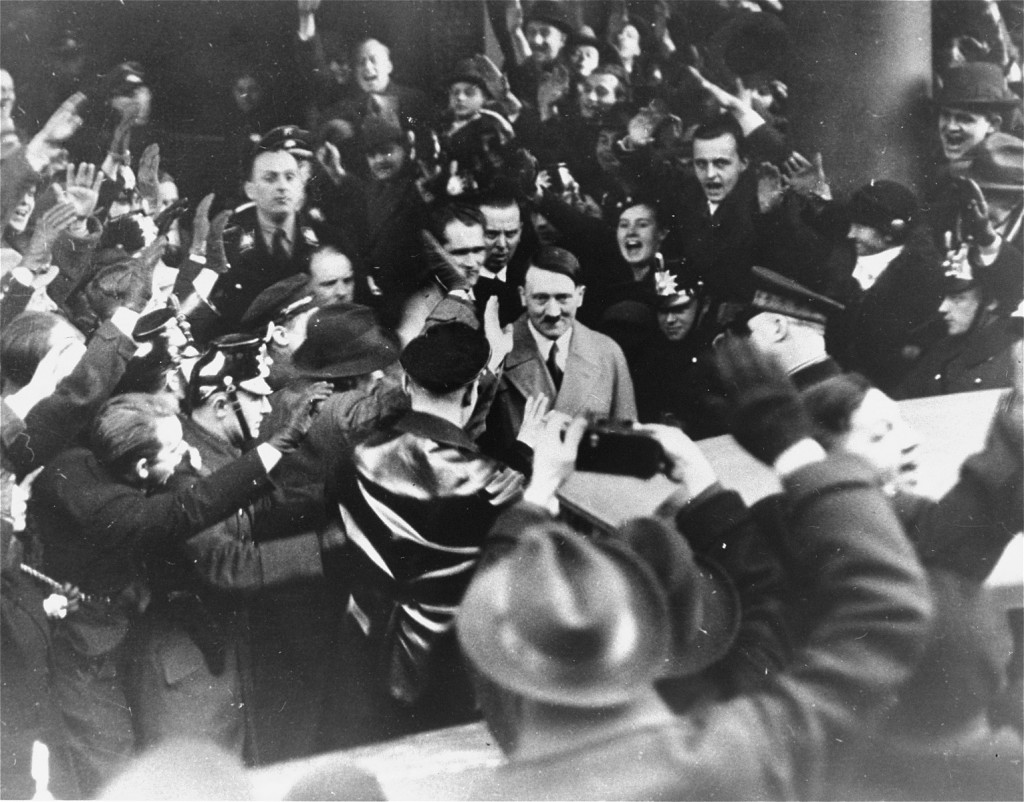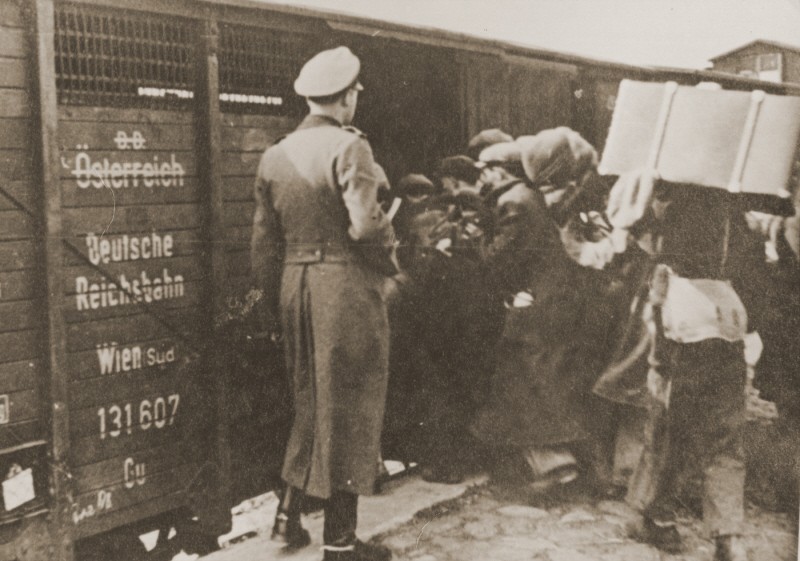Kurt Gerstein
German SS officer Kurt Gerstein was assigned to the Hygiene Institute of the Waffen SS. He was called upon to assist in the implementation of the "Final Solution." Gerstein witnessed atrocities at the Belzec and Treblinka killing centers. He tried to inform foreign diplomats, Vatican officials, and members of the political resistance within Germany about Nazi German atrocities. While in Allied custody after the war, Gerstein wrote a report documenting the atrocities he had witnessed.
Key Facts
-
1
Kurt Gerstein joined the Nazi Party in 1933. Nonetheless, he later participated in religious-based anti-Nazi activity. As a result, he was expelled from the Nazi Party and arrested several times.
-
2
Gerstein was readmitted into the Nazi Party in 1939 and subsequently joined the SS. Assigned to the Hygiene Institute of the Waffen SS, he was tasked with delivering Zyklon B to Auschwitz and other camps.
-
3
As an official of the Hygiene Institute, Gerstein observed a mass killing at the Belzec killing center. He later recorded what he had witnessed in the "Gerstein Report."
Kurt Gerstein (1905–1945) was an SS officer assigned to the Hygiene Institute of the Waffen SS. In this role, he was called upon to assist in the implementation of the “Final Solution.”
Early Years and Family Life
Gerstein was the sixth of seven children born to a well-established Lutheran family in the German city of Münster. Gerstein's father was a harsh authoritarian figure and ardent nationalist. He instilled an unwavering patriotism in his children. Gerstein's mother died when he was young. Although an exceptionally bright child, Gerstein was a less than ideal student. He skipped classes, ignored his schoolwork, and was even known as a prankster. Despite his flawed scholastic record, he went on to study mining engineering at the universities of Marburg, Aachen, and Berlin, earning his degree in 1931. While studying at Marburg, Gerstein mirrored his father’s chauvinistic attitudes. He joined Corps Teutonia Marburg, one of Germany’s most ultra-nationalistic fraternities.
Initially, Gerstein felt it was his patriotic duty to support the Nazis. His strong nationalist sentiments drove him to join the Nazi Party in May 1933, just five months after Hitler's appointment as Chancellor.

Church Membership and Expulsion from the Nazi Party
Although not exceptionally pious as a boy, Gerstein began to read the Bible while studying at university. His efforts were likely in response to the drinking and carousing he observed among his fellow fraternity members. At Marburg he became active in Christian student and youth movements, supporting the Christian education of young men.
In 1934, he gravitated towards the Confessing Church (Bekennende Kirche). This movement opposed the effort to unify the German Protestant churches into a single, pro-Nazi establishment. Gerstein became dedicated to the movement, despite his father’s disapproval. It was through his involvement with the church that he first came into conflict with the Nazi regime. As the preachings of the Confessing Church failed to square with Nazi doctrine, the German state gradually impinged upon the church and its organizations. Gerstein felt that he had to choose between defending his church and supporting his nation. He chose his church.
At the end of January 1935, Gerstein attended a performance of the play Wittekind. The play’s pro-Nazi and anti-Christian message goaded him into action. Gerstein stood up during the performance, declaiming its neo-pagan rhetoric, and was promptly beaten by SA (Storm Trooper) members in the audience. The following year, Gerstein was arrested for conducting an anti-Nazi pamphlet campaign in favor of preserving church autonomy. He was held for five weeks in protective custody and expelled from the Nazi Party.
Unable to find work after his expulsion, Gerstein returned to school to study medicine. On August 31, 1937, he married Elfriede (née Bensch), a pastor’s daughter. From 1936 until 1938, they lived in Tübingen. In July 1938, Gerstein was arrested a second time on suspicion of anti-Nazi activities. However, he was released after six weeks.
Membership in the SS
Gerstein was readmitted to the Nazi Party with provisional membership on June 10, 1939. In this effort he had the help of his father and several influential Nazi Party and SS Officials. Membership allowed Gerstein to continue his career in mining engineering in the state sector, which almost always required Nazi Party affiliation.
In mid-February 1941, Gerstein discovered that his sister-in-law, Berta Ebeling, had died at a psychiatric hospital in Hadamar, Germany. Hadamar was one of six clandestine killing centers operating in the Nazis’ so-called Euthanasia Program. Gerstein had heard rumors that the German government had embarked on the systematic murder of persons with disabilities who were living in institutions. He began to suspect, correctly, that his sister-in-law had been murdered. Ebeling's death added to a growing list of factors contributing to Gerstein's curiosity and concern about what was happening behind the scenes in Nazi Germany. He decided the best way to find out was to join the SS, a move that would clear him of suspicion, given his past opposition to Nazi rule.
Gerstein trained for two months in a medical corps. On June 1, 1941, he was assigned to the Hygiene Institute of the Waffen SS in Berlin. Here, Gerstein distinguished himself through his comprehensive understanding of engineering and sanitation. His most important contribution was in the development of techniques for vermin control and maintaining quality drinking water for combat troops. On November 1, 1941, he was appointed as a specialist, SS Second Lieutenant, in the Waffen SS. On April 20, 1943, he was promoted to SS First Lieutenant in the Waffen SS.
Because of his position in the Hygiene Institute and his expert knowledge of decontamination techniques, Gerstein came to learn of the implementation of the "Final Solution." He was responsible for the delivery of large quantities of Zyklon B to Auschwitz and other camps. He also was invited to inspect the Aktion Reinhard killing centers at Belzec and Treblinka. At these sites, the SS staff used carbon monoxide gas produced by large diesel engines to murder prisoners in the gas chambers. In August 1942, he observed a mass killing of Jews at Belzec. He later described this murder as follows:
Mothers with little children at the breast, little naked children, adults, men, women, all naked - they hesitate but they enter the death chambers, pushed forward by those behind them or driven by the leather whips of the SS. The majority without saying a word. … Many people pray. I pray with them, I press myself in a corner and shout loudly to my and their God. How gladly I would have entered the chamber together with them, how gladly I would have died the same death as them. Then they would have found a uniformed SS man in their chambers - the case would have been understood and treated as an accident, one man quietly missing. Still I am not allowed to do this. First I must tell what I am experiencing here! …
—Kurt Gerstein, “Gerstein Report,” 1945

Witness and Suspect
In his postwar confession, Gerstein recorded what he saw at Belzec in great detail. He described the process by which trainloads of Jews entered the camp, how their possessions were taken and their hair shorn. He also described how the Jews were made to undress and enter the gas chamber, how they were packed so tightly that they could not collapse as they suffocated. He later maintained that this experience made him determined to inform the world of the horrors taking place in the killing centers.
A few days after Gerstein visited Belzec and Treblinka, he had a chance encounter with Swedish diplomat Göran von Otter on a Berlin-bound train. This meeting gave Gerstein the opportunity to tell the diplomat what he had seen and urge him to spread the information internationally. Gerstein also made efforts to circulate his story to Swiss diplomat Paul Hochstrasser, to Vatican officials, and to the representatives of the Dutch government-in-exile. He also made efforts to inform members of the Confessing Church and of the political resistance within Germany.
Sadly, Gerstein’s revelations were never conveyed to the Allied governments.

Gerstein’s Surrender and Execution
By April 1945, the destruction of the Third Reich was imminent. Gerstein surrendered himself to French authorities in southwestern Germany. In his statement, he declared that he had given himself up so that the Allies might use his knowledge to punish those responsible for murder.
Ironically, however, Gerstein became not a witness but a suspect. At the end of May 1945, he was moved from a hotel where he had been staying under house arrest to the jail in Konstanz and later to Cherche-Midi Prison in Paris.
While in custody, Gerstein wrote what is now known as the Gerstein Report. In this report, Gerstein recounted all that he had seen during his service with the SS. It was here that he described his experience at Belzec and his conversations with von Otter and other foreign officials. On July 25, 1945, Gerstein was found hanged to death in his cell. It is likely that his anguish in being cast as a war criminal, as well as his despair at failing to halt the “Final Solution,” drove him to suicide. However, rumors persist that fellow SS members may have murdered him for betraying information about the Holocaust.
On August 17, 1950, a denazification tribunal in Tübingen found Gerstein to have been a Nazi offender for his assistance in the production and delivery of Zyklon B. His widow was denied a pension. In January 1965, almost 15 years later, with the help of Baron von Otter and other well-placed supporters, Gerstein's wife obtained a posthumous pardon for him from the Federal Republic of Germany.

